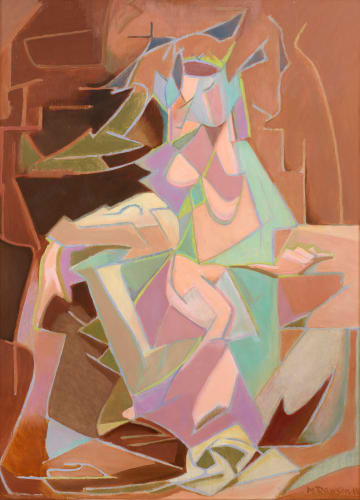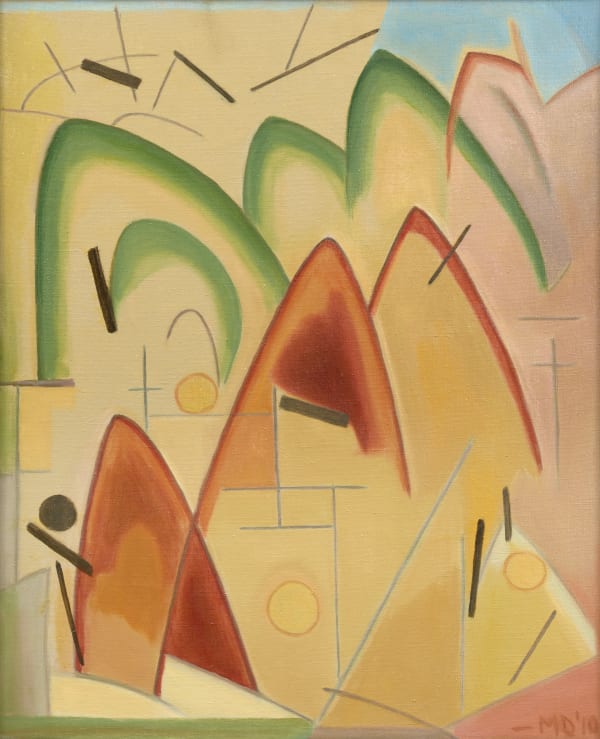Manierre Dawson American, 1887-1969
Biography
Manierre Dawson occupies a special place in American art history as one of the earliest contributors to abstract art. His influences were many, but his quasi-cubist experiments in the 1910s notably developed largely apart from any significant awareness of Picasso or Kandinsky. Difficulty in dating many of these ground-breaking works has obscured their profound originality: whether or not he was the first to summit the mountain of abstraction, his path there was uniquely his own and certainly represents an extraordinary achievement.
Born in Chicago in 1887, Dawson was given his mother's maiden name, Manierre, in honor of his maternal grandfather. Edward Manierre was an alderman and treasurer of the city of Chicago in the 1850s. The painter's father was more humble in origins, descending from farmers, but nonetheless ascended to practicing law and speaking six languages. The painter's parents married in September of 1885, and Manierre was born two years later, joining a growing family in their newly-built Prairie Avenue home in Chicago. The family found a small summer home off the shore of Lake Michigan, beginning what for Dawson would be a life-long association with Michigan. Early drawings of "The Humps," as the house there would be known, demonstrate Dawson's extraordinary skill as a draftsman.
Dawson's only formal artistic training came in high school, where he absorbed with interest the diverse influences of James Abbott McNeil Whistler and Arthur Wesley Dow, likely via his art teacher, Katherine Dimock. Just as Dawson was perfecting his realist technique in high school, tragedy struck: his older brother, George Jr., drowned at the lake house. Manierre was in no way responsible for what was certainly an accident, but the passing of his father's favorite son exacerbated a distance between Manierre and George, Sr., in addition to the trauma of losing a brother. A talented, inward child turned inward further.
While his realist manner continued for several years, by 1906 and Manierre's graduation from high school, he had also developed a style of fantastical painting, closer to Arthur B. Davies than perhaps anyone else. Dawson was introduced to Davies' work by a friend of his mother's, Kate Kellogg. Davies had studied in Chicago in the 1880s and early 1890s before moving to New York, and Kellogg's older sister, Alice, had been romantically involved with him. In 1910, Dawson mentioned this influence in his journal. There is a limited relationship in pictorial treatment between the two painters, but Dawson seems to have found an outlet for a difficult emotional period in his young life. Paintings that followed are possessed of a gothic romantic morbidity, with titles like Twilight, Dreamer, and, pointedly, Children and Ghosts. When he graduated from high school, Dawson enrolled at Armour Institute of Technology. "Manierre certainly does not believe in doing any more work than he really has to do," observed on instructor; "If I could choose a life work it would be the painting of pictures," he decided [Ibid., p. 24]. Those pictures, increasingly, represented
an escape from reality, not its embrace.
Dawson's parents ran in very cosmopolitan circles, and his interests followed these - and found further support in the exhibitions at the Art Institute of Chicago. He could have seen Native American art alongside Alphonse Mucha there as early as 1906, Japanese wood-block prints shortly thereafter. Couple an inquisitive and imaginative mind with the technical drawing exercises he dutifully undertook at Armour Tech and you have a young man primed for creating paintings of extraordinary novelty. By 1908, this had come to pass: moving through the magic realism, he flattened planes and began abstracting forms into the arabesques and arches that he studied in engineering. "I feel I am beginning to grasp something that may eventually be of worth, certainly to myself and maybe to others," he wrote that year [Ibid., p. 25].
Along with paintings from the Hudson River School and examples of American Impressionism, Dawson saw at the Art Institute of Chicago Ashcan paintings by John Sloan, proto-modernist paintings by Hugh Henry Breckenridge (1906) and Alfred Maurer (1907), etchings by Whistler (1907) and a robust selection by the Eight (1908). Dawson's work during these years begins what is inarguably a form of cubism. While it was clear that Dawson was a sophisticated and talented aesthete, it is not clear at all that he saw fine examples of European vanguard modernism in these years. Most notable about his deviations from what might be considered conventional of his European counterparts is the difference in color: Dawson's palette is unlike anything Matisse or Picasso or Cézanne used. It is richer and brighter and at times more decorative than the work of the Fauves, more chromatic than the muddy brown cubist canvases the Braques and Picasso would collectively turn out. If he was exposed to any of these developments at all, it must have been through black-and-white reproduction. It's not surprising, then, that his palette does resemble Americans whose canvases we know he could have seen: Breckenridge, Maurer, and a generation of Impressionists whose work was brightening and enriching in just these years.
In 1910, that physical distance from the geographic heart of Modernism - narrowed: Dawson embarked on a grand tour of Europe. He travelled by train to Montreal and then on to Liverpool by steamer. Two weeks in Paris were followed by a trip to Cologne, then Zurich, and on to Milan. He met - apparently by accident - John Singer Sargent in Siena, before continuing a tour of Italy. He returned to Paris, and managed an introduction to Gertrude Stein. Against all probability, Stein bought a picture from the young painter. This was Dawson's first ever sale, but more importantly, it exposed him to the artists in Stein's collection: the very finest examples of modernism, perhaps anywhere. Of these, he noted only Cézanne in his journal. Dawson finished
this year by meeting Arthur B. Davies in New York, finally returning to Chicago. "I think I have been most affected by Cézanne, who, in the few works of his I have seen, doesn't take the scene at face value but digs into the bones and shows them," he reflected.
That's where Dawson was when Modernism finally exploded in America, at the 1913 Armory Show: in Chicago. In 1912, Davies had inquired after works by Dawson, but found Dawson's largely home-grown cubism too abstract for his own tastes. Dawson had left behind whatever element of his painting had been influenced by Davies by the time he met the man. Dawson was ultimately not included in the New York show, but when it travelled to Chicago, one of the organizers, Walter Pach, snuck one of Dawson's works into the exhibition. Even more important was what Dawson took from the show: He bought a painting by Duchamp, Nude (Study), Sad Young Man on a Train. He lived with the work for nine years, before selling it to Pach. He in turn, sold it to Peggy Guggenheim, in whose collection in Venice the work now hangs.
The influence of the work on Dawson, for the rest of the decade, is undeniable. Just as important, however, is the fact that Dawson received the work because he was a kindred spirit. Sad Young Man on a Train is close kin to Nude Descending a Staircase: the most scandalous painting at the Armory Show. Few admired the picture, fewer understood it, and virtually no one alive can have been said to have been working along similar lines. Perhaps Dawson cannot be admitted to this last group: his working method and the arch of his aesthetic theory is ultimately entirely different from Duchamp's, as the rest of their careers would mutually reveal. However, the point of visual intersection is uncanny, as parallel idioms of movement, plane, and diagram intersected at this exciting juncture in 1913.
Works
-
 Manierre DawsonFlowers in a Yellow Vase, 1906
Manierre DawsonFlowers in a Yellow Vase, 1906 -
 Manierre DawsonBlue Vase and Nuts, 1909
Manierre DawsonBlue Vase and Nuts, 1909 -
 Manierre DawsonPrognostic (Right Panel of Triptych), 1910
Manierre DawsonPrognostic (Right Panel of Triptych), 1910 -
 Manierre DawsonMadonna, 1911
Manierre DawsonMadonna, 1911 -
 Manierre DawsonLucia, 1911
Manierre DawsonLucia, 1911 -
 Manierre DawsonStill Life — Blue Objects, 1912
Manierre DawsonStill Life — Blue Objects, 1912 -
 Manierre DawsonDependent Impression, 1912
Manierre DawsonDependent Impression, 1912 -
 Manierre DawsonThe Stack, 1912
Manierre DawsonThe Stack, 1912 -
 Manierre DawsonAscension, 1913
Manierre DawsonAscension, 1913 -
 Manierre DawsonSunstrike, 1913
Manierre DawsonSunstrike, 1913 -
 Manierre DawsonUntitled Abstraction, 1913
Manierre DawsonUntitled Abstraction, 1913 -
 Manierre DawsonRelations, 1913
Manierre DawsonRelations, 1913 -
 Manierre DawsonUp Conderr, 1913
Manierre DawsonUp Conderr, 1913 -
 Manierre DawsonArray in Brown, 1913-14
Manierre DawsonArray in Brown, 1913-14 -
 Manierre DawsonNight Figures, 1914
Manierre DawsonNight Figures, 1914 -
 Manierre DawsonMonument by the Sea, 1917
Manierre DawsonMonument by the Sea, 1917 -
 Manierre DawsonEquation, 1919
Manierre DawsonEquation, 1919 -
 Manierre DawsonApollo, 1919
Manierre DawsonApollo, 1919 -
 Manierre DawsonBrown Equation, 1919
Manierre DawsonBrown Equation, 1919 -
 Manierre DawsonMex Theme, 1933
Manierre DawsonMex Theme, 1933 -
 Manierre DawsonUntitled Abstraction, c. 1921
Manierre DawsonUntitled Abstraction, c. 1921
Exhibitions
-

Now Modern Spring 2023
May 5 - July 7, 2023The Spring 2023 edition of Now Modern presents a selection of works by Charles Demuth, Richard Estes, Marsden Hartley, Fitz Henry Lane, Norman Lewis, John Marin, Georgia O'Keeffe, John Frederick...Read more -

Now Modern
Fall 2022 November 16 - December 16, 2022Schoelkopf Gallery is pleased to continue its biannual exhibit and accompanying publication Now Modern this Fall and Winter. The publication and exhibition is an extension of the gallery’s mission and...Read more -

Now Modern
May 9 - June 10, 2022Read more
Art Fairs
News


























